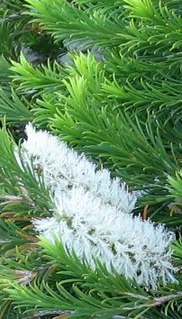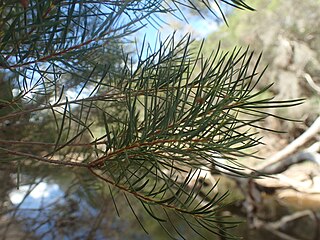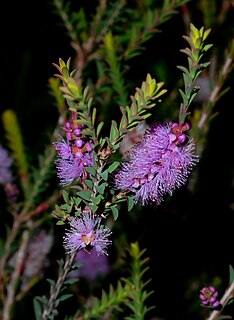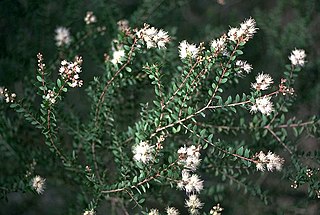
Melaleuca armillaris, commonly known as bracelet honey myrtle, is a plant in the myrtle family, Myrtaceae, and is native to South Australia, Victoria and Tasmania in south-eastern Australia. It is a hardy, commonly grown species, often used as a fast-growing screen plant, but it also has the potential to become a weed. It has become naturalised in Western Australia and parts of Victoria. In its natural state, it grows on coastal cliffs and along estuaries.

Melaleuca trichostachya is a plant in the myrtle family, Myrtaceae and is native to inland northern New South Wales, Queensland, South Australia and the Northern Territory in Australia. It is a small tree, similar to the commonly cultivated Melaleuca styphelioides, with its prickly foliage and fluffy spikes of white or cream flowers but there are differences in the leaf arrangement and fruiting capsules.

Melaleuca halmaturorum, commonly known as South Australian swamp paperbark, kangaroo honey-myrtle or salt paper-bark is a plant in the myrtle family, Myrtaceae and is endemic to Western Australia, South Australia and Victoria. It is often a tree with an unusual, crooked form, sometimes looking like an enlarged example of bonsai.
Melaleuca penicula is a plant in the myrtle family, Myrtaceae and is endemic to the south of Western Australia. It is a rare species only known from the Fitzgerald River National Park and resembles Melaleuca eximia with its spikes of red flowers but its leaves and stamen bundles are different.

Melaleuca beardii is a plant in the myrtle family, Myrtaceae and is endemic to the south-west of Western Australia. It is similar to a number of other Western Australian melaleucas such as M. trichophylla with its purple pom-pom flower heads but unlike others, the tips of its leaves are rounded rather than pointed.
Melaleuca boeophylla is a plant in the myrtle family, Myrtaceae and is endemic to the south-west of Western Australia. It is similar to a number of other Western Australian melaleucas such as M. filifolia with its purple pom-pom flower heads but its leaves are shorter and oval in cross-section.
Melaleuca keigheryi is a shrub in the myrtle family, Myrtaceae with white, papery bark and is endemic to the west coast of Western Australia. In spring, it has heads of pink flowers which fade in color to become white.

Melaleuca wonganensis is an erect shrub in the myrtle family Myrtaceae and is endemic to the south-west of Western Australia. It is a shrub with narrow leaves and purple to deep mauve flowers and is restricted in its distribution to the Wongan Hills district.

Melaleuca strobophylla is a shrub or small tree in the myrtle family Myrtaceae and is endemic to the south-west of Western Australia. It has papery bark, sharply pointed, twisted leaves and rather long spikes of creamy white flowers in summer.

Melaleuca decussata, commonly known as cross-leaf honey-myrtle or totem poles, is a plant in the myrtle family, Myrtaceae native to South Australia and both native and naturalised in Victoria. It is an adaptable shrub, grown in many parts of Australia for its attractive foliage but is regarded as an environmental weed in parts of Victoria.

Melaleuca nodosa, commonly known as the prickly-leaved paperbark, is a plant in the myrtle family Myrtaceae, and is endemic to eastern Australia. It is a shrub or small tree with narrow, sometimes needle-like leaves and profuse heads of yellow flowers as early as April or as late as January.

Melaleuca acuminata, commonly known as mallee honeymyrtle is a plant in the myrtle family, Myrtaceae and is native to Australia and widespread in temperate areas of the continent. It is an erect shrub to about 3 m (9.8 ft) usually found in mallee woodland.
Melaleuca xerophila is a shrub or small tree in the myrtle family Myrtaceae and is native to arid parts of South Australia and Western Australia. It is a large shrub with narrow leaves and heads of white or cream-coloured flowers in spring.

Melaleuca leiocarpa, commonly known as pungent honey-myrtle, is a plant in the myrtle family, Myrtaceae and is native to arid areas in parts of South Australia and Western Australia. It is an erect or branching shrub distinguished by its prickly foliage, yellowish flowers and, for a melaleuca, unusually large, smooth, roughly spherical fruits.

Melaleuca cheelii is a plant in the myrtle family, Myrtaceae and is endemic to the Wide Bay–Burnett region of Queensland. It is a shrub or tree to 10 m (33 ft) with white flowers and papery bark. It has been classified as "near threatened" by the government of Queensland.

Melaleuca filifolia, commonly called wiry honey-myrtle, is a plant in the myrtle family Myrtaceae, and is endemic to the south-west of Western Australia. It is a woody, twiggy shrub with needle-shaped leaves, greenish flower buds, pink "pom-pom" flower heads and spherical clusters of fruits.
Melaleuca nanophylla, commonly known as dwarf-leaved honey-myrtle is a rare plant in the myrtle family, Myrtaceae and is endemic to two small areas, one in Western Australia and the other in South Australia. It has tiny leaves with their upper surfaces pressed against the stems and small heads of white or pale yellow flowers.

Melaleuca parvistaminea is a plant in the myrtle family, Myrtaceae, and is endemic to the states of New South Wales and Victoria in Australia. It has hard, rough bark, cream coloured flowers and leaves in whorls of three around the stems.

Melaleuca spathulata is a shrub in the myrtle family, Myrtaceae, and is endemic to the south-west of Western Australia. It is a well known garden shrub featuring dark green leaves against light-coloured foliage, many twisted branches and profuse heads of bright pink "pom pom" flower heads in spring or early summer.

Melaleuca pyramidalis is a plant in the myrtle family, Myrtaceae and is endemic to small areas of Queensland in Australia. It is closely related to Melaleuca citrina but is distinguished from it mainly by leaf and stamen differences. Melaleuca pyramidalis is only known from the summits of three mountains in Queensland.

















